We’ve teamed up with Hayden Paddon, Kiwi World Rally Championship (WRC) stage winner, and Kirsten Corson, an EV enthusiast to cover all things EV to help you make the switch to drive electric.
We’ve teamed up with Hayden Paddon, Kiwi World Rally Championship (WRC) stage winner, and Kirsten Corson, an EV enthusiast to cover all things EV to help you make the switch to drive electric.
Music and sound of revving car engine: Opens with branded rally car doing donuts spraying dirt. The words “Charging ahead with Paddon – EV roadie” with the Meridian Energy logo appear on screen.
Scene changes to show Hayden Paddon staying in front of a building that has a Paddon Rally Sport Group sign on it. He is standing between two cars. One is a standard white Hyundai EV and the other is his Hyundai Kona EV rally car that is full of branding.
Hayden: Hi, I’m Hayden Paddon, New Zealand rally driver and this is our Hyundai Kona full electric rally car.
Hayden voice over while seeing the Hyundai Kona EV speeding on a dirt road cornering at speed: It’s fun. It's fast and it’s 800 kilowatts of four-wheel drive power.
See white Hyundai EV from above driving on a winding road on the side of a big lake with mountains in the background followed by image of windfarm – turbines slowing spinning on the top of hills. Then see EV driving on South Island roads, followed by a close up of an EV being plugged in to charge: Today we’re going on a Meridian EV roadie down to a windfarm to see where some of New Zealand’s renewable energy comes from. And along out trip we’ve going to ask some of the key EV questions, both for myself and for you to help make the switch. Let’s go.
Hayden voice over while seeing car driving and then see scene of Queenstown Lake front on a clear day: Just like me, Meridian Energy is passionate about helping Kiwis make the switch to electric vehicles.
Hayden voice over, see Kirsten standing on the lake front taking a photo of the scenery: Joining me on the road trip is EV enthusiast Kirsten Corson.
See Hayden inside the pulling up to pick up Kirsten. Kirsten is smiling and climbs in the passenger seat. Hayden says: You want to head away on a road trip?
Kirsten answers: Absolutely!
Hayden: I’ve got a nice little trip planned.
See car pulling away from lake front as Kirsten says: Sounds great. I’m keen.
Hayden voice over while seeing car driving on various roads: Our first stop is Meridian’s wind farm but before we get there, let’s get some of your EV questions answered.
See Hayden and Kirsten sitting in the car, and he is driving. Hayden says: So, I guess while we’re on our road trip, you’re the expert of EV so you can probably teach me a few things. So, I’m wanting to know, how’s the charging infrastructure in New Zealand and if I want to charge on this road trip – what's going to be the quickest and best way to charge this thing once we get to our destination?
Kirsten’s title appears on screen – Kirsten Corson, EV Enthusiast. She picks up her phone and answers Hayden: Well, we can have a look on PlugShare, on the PlugShare app, and that shows you all the public chargers that are available. See hand holding a mobile phone with the PlugShare app open. On the screen we can see a map of the lower South Island showing a lot of pins on the map. See the map being zoom in and a pin being selected which brings up the details of the specific EV charger chosen.
And the brown pins are the fast DC chargers, and the green pins are the slower AC chargers. So, I guess the mind shift too with EVs is it’s not like a petrol station mentality where you stop once a week, it’s a bit like having a cell phone. So, when you near you near a charging station you just plug it in and top it up.
I guess there’s some EV etiquette though you’d need to learn Hayden.
Hayden chuckles: Oh no.
Kirsten talking to Hayden: So, you obviously are looking at your range and how much you’ve got and then how much do you actually need so there’s no point in paying more for public charger and clogging up the charger when you got people waiting behind you when you only actually need seventy kilometres to get to our next destination and it’s also more cost effective to charge at home. So the majority of Kiwis, just charge their EVs at home and they just use the public chargers when they are going out and about doing road trips like we are today.
Hayden: Oh yeah, I see. But what happens if I don’t have a fast charger at home, or the smart charger?
Kirsten: So, you can just use your three pin plug.
Hayden: Yeah, I see.
Kirsten: Yeah, so
Hayden: A bit slower though, isn’t it?
Kirsten: It is a lot slower, yeah. But if you think about it, the majority of trips we do each day in our car are actually a lot less than we think. So, it’s actually around twenty-nine kilometres we travel each day in our car. So, the need to to use the fast public chargers is only if we’re not charging at home.
Hayden: Oh, I see.
Kirsten: Also, the other thing to take into account is the cost of charging. So, if we were to plug this in tonight it would cost you less than ten dollars to top it up.
Hayden: Ten bucks for a full tank?
Kirsten: So, you...Yeah, for a full tank. So as an average rule of thumb to charge at home it’s five dollars for a hundred kilometres, if you’re using a public charger, it would be around fifteen dollars for one hundred kilometres but if you are driving a petrol car it’s around eighteen dollars for one hundred kilometres.
Hayden: I see, so it’s substantially cheaper then.
Kirsten: Yeah.
Hayden: Yeah, especially with the price of fuel and oil now days.
See EV from above taking a fork in the road as the conversation continues in the background.
Kirsten: Exactly. Since I’ve run those numbers it probably around twenty-five dollars for petrol.
Music comes in. See car from behind driving up a hill with wind turbines on the top of the hills in the background.
Hayden voice over: Don’t miss our next video where we’ll cover off more of your EV questions.
Music ends. Merdian logo on screen with the words ‘The Power to Make a Difference’.
It may seem strange for a power company obsessed with decarbonisation to sponsor a rally driver, but did you know that Hayden and his team developed the world's first fully electric rally car in 2020? Built right here in Cromwell by a 10 man team with the goal of proving that an all-electric rallying can be the future for rally sport.
Currently the Hyundai Kona EV has the power equivalent to a current world rally car but with a much shorter range using a prototype 23kWh battery. This year the team plan to upgrade the battery to a 54kWh that’s expected to produce a 50km range in rally mode. Most WRC stage loops are under 50kms allowing the team to achieve the range with the performance.
When asked about recharging on a rally, Hayden explains that the EV Kona has been designed so that a battery change can be completed in just 8 minutes making it a practical solution to do a full rally.
Hayden is also an outspoken voice in the rally community advocating for the sport to evolve and embrace alternative-fuel vehicles.

Haydon Paddon with his electric rally car; the Hyundai EV Kona in action; Hayden Paddon and Kirsten Corson
In this episode we cover some key EV questions from drivers who are looking to make the switch.
According to EECA who've kindly done the math, on average it will cost the following to charge an EV for 100kms*
Compared to $18 for 100kms for a petrol car*.
Beyond saving big on petrol costs, it’s quicker than you might think to recharge an EV on route. Using a fast charger to add an additional 100kms to the battery only takes 20-30 minutes. As charging at home is the cheapest and often the most convenient option, 82% of EV owners do most of their charging at home.
*These costs are based on current rates as at 5 December 2022: standard home electricity rate of 29c/kWh; average petrol premium unleaded 95 cost at $2.34/L used at a fuel efficiency of 6.9L/100km.
The Ministry of Transport found that on average Kiwis drive 30kms a day and 90% of all car travel is for trips less than 90kms. That means for some EV drivers, there’s no need to use public chargers at all unless they’re on a road trip.
It’s easy to find public chargers on route using the PlugShare app. It shows you all the public chargers available on a map within the app. There are two types of chargers shown, brown pins represent fast DC chargers, and green pins are for slower AC chargers.
Only use public chargers to charge your EV to what you need to get to your destination. There’s no point paying more for a public charger if there’s other drivers waiting when charging at home is much cheaper.
*Ts&Cs, break fees and eligibility criteria apply. Credit valued at $35/month and only available on our EV Plan.
^Cheaper charging is calculated comparing the night vs day rates on Meridian’s EV plan. Savings vary by network.
Thinking of making switch? We’ve got info on what they cost, why they’re great and heaps more to help you on your journey.
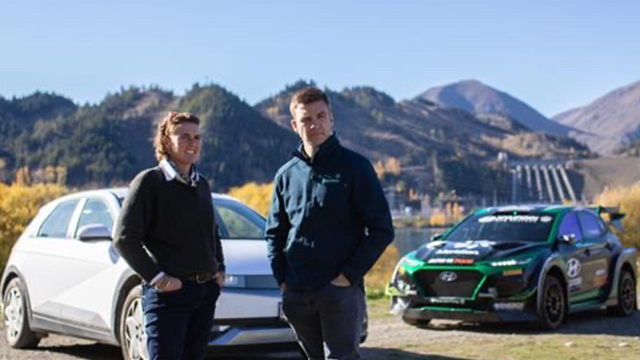
We’re back with Hayden Paddon, Kiwi World Rally Championship (WRC) stage winner, and Kirsten Corson, EV enthusiast, to cover all things EV to help you make the switch to drive electric.
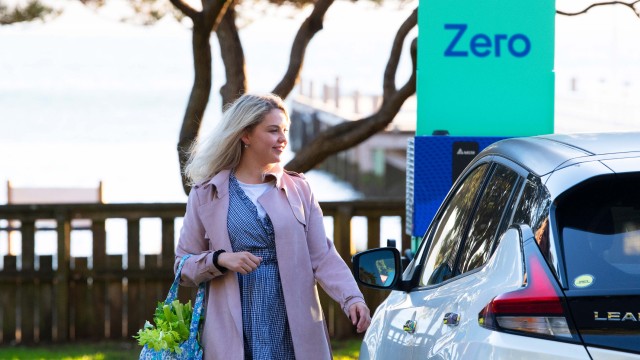
Wondering what the difference is between hybrid and fully electric cars? We’ve listed the pros and cons for both.
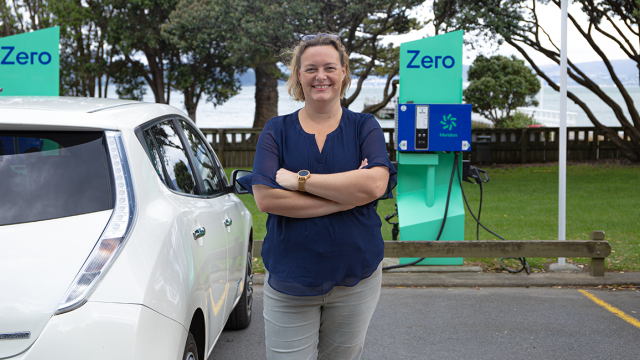
We chatted with Sophie about buying and owning a second-hand Nissan Leaf and how that’s working out for her family.
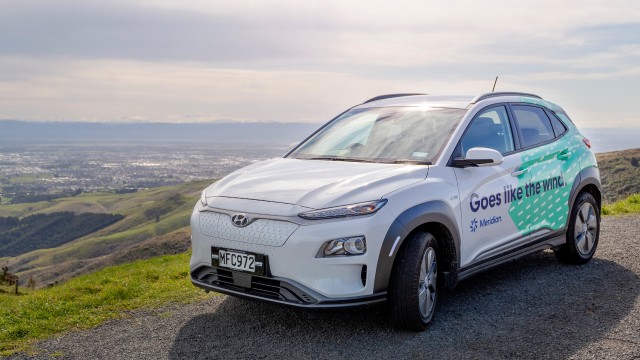
There are heaps of benefits to driving an electric vehicle. We’ve narrowed it down to the top six reasons to go electric.
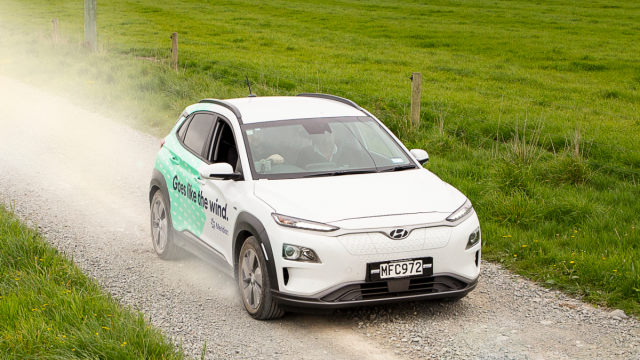
Electric cars are all well and good, until you remember you’re not a townie and your nearest charging station is an hour’s drive away. Right? Well... not quite.